Trigger Point Therapy for Myofascial Pain (18 page)
Read Trigger Point Therapy for Myofascial Pain Online
Authors: L.M.T. L.Ac. Donna Finando

Stretch exercises:
- Using the unaffected arm, pull the affected arm across the back at the level of the waist and pull up slightly. Hold this position for a count of fifteen to twenty.
- As flexibility increases, reach the fingers of the affected arm toward the inferior angle of the opposite shoulder. Hold for a count of fifteen to twenty.
Strengthening exercise:
Abduct the arms, keeping the elbows straight. Abduct to a count of two; return to the starting position to a count of four. Repeat eight to ten times, increasing the number of repetitions as strength allows. Hand weights may be used to increase the work effort of the muscle. Supraspinatus will work in the first 15 to 20 degrees of abduction, before deltoid fully activates.
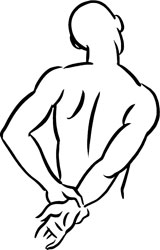
Stretch exercise 1: Supraspinatus
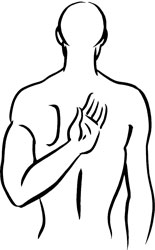
Stretch exercise 2: Supraspinatus

Infraspinatus and trigger points
I
NFRASPINATUS
Proximal attachment:
Medial two-thirds of the infraspinatus fossa, which lies distal to the spine of the scapula.
Distal attachment:
Posterior aspect of the greater tuberosity of the humerus, distal to the attachment of supraspinatus.
Action:
External rotation of the arm; aids in stabilizing the head of the humerus in the glenoid fossa during upward movement of the arm, assisted by teres minor.
Palpation:
Infraspinatus is one of the four muscles that comprise the rotator cuff. The other muscles of the rotator cuff are supraspinatus, teres minor, and subscapularis. Constrictions and trigger point activity in infraspinatus is one of the most common causes of shoulder pain. It is third only to upper trapezius and levator scapulae in frequency of involvement in trigger point activity.
To locate infraspinatus, identify the following structures:
- Infraspinatus fossa of the scapulaâThe aspect of the scapula that lies distal to the spine of the scapula.
- Greater tuberosity of the humerusâDistal to the lateral aspect of the acromion, easiest palpated when the arm is in external rotation. Differentiate the greater tuberosity from the lesser tuberosity, and locate the bicipital groove, which lies between them.
To palpate infraspinatus use flat digital palpation within the infraspinatus fossa, beginning at the medial (vertebral) border of the scapula and moving laterally toward the insertion at the greater tuberosity of the humerus. Constrictions and trigger points are most commonly found approximately ½ to 1 inch distal to the spine of the scapula.
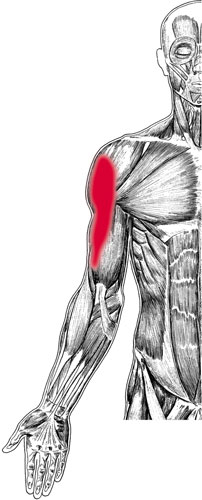
Infraspinatus (anterior) pain pattern
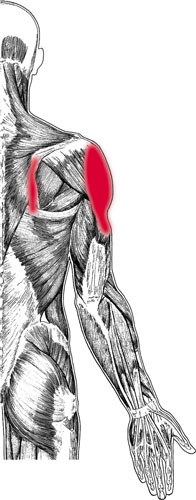
Infraspinatus (posterior) pain pattern
Pain pattern:
Proximal trigger points refer pain deep in the anterior deltoid region and the shoulder joint, extending down the front and lateral aspects of the arm and possibly the forearm and the radial half of the hand. Pain may extend to the suboccipital region and posterior cervical areas. Distal trigger points refer pain between the spine of the scapula and the vertebral border of the scapula. Pain is experienced when sleeping on either side. The patient may be unable to reach behind his back.
Causative or perpetuating factors:
Overload stresses while reaching backward and upward.
Satellite trigger points:
Teres minor, anterior deltoid, posterior deltoid, biceps brachii, supraspinatus, teres major, latissimus dorsi.
Affected organ system:
Digestive system.
Associated zones, meridians, and points:
Dorsal zone; Hand Tai Yang Small Intestine meridian; SI 9, 10, and 11.
Stretch exercises:
- Starting with the affected arm at 90 degrees horizontal abduction, extend the arm toward the back, internally rotating at the shoulder. At the limitation of extension, bend the elbow and touch the inferior angle of the opposite scapula.
- Pull the affected arm across the chest, using the other arm placed proximal to the elbow to guide the action.
Strengthening exercise:
Lie supine with the arm close to the torso and the elbow flexed to 90 degrees. Without moving the elbow and arm away from the torso, rotate the forearm as if to place the back of the hand on the floor. Return to the starting position.
Repeat eight to ten times. Hand weights may be used as strength develops, to increase the work effort placed on the muscle.
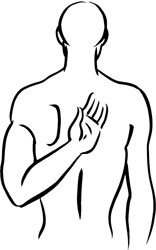
Stretch exercise 1: Infraspinatus
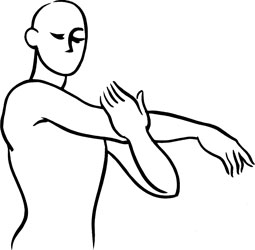
Stretch exercise 2: Infraspinatus

Teres minor and trigger point
T
ERES
M
INOR
Proximal attachment:
Proximal two-thirds of the lateral border of the scapula, on the dorsal surface.
Distal attachment:
Posterior aspect of the greater tuberosity of the humerus, distal to the attachment of infraspinatus.
Action:
External rotation of the arm at the shoulder; acts with the infraspinatus to stabilize the head of the humerus during movement of the arm.
Palpation:
Teres minor is one of the four muscles that comprise the rotator cuff. The other muscles of the rotator cuff are supraspinatus, infraspinatus, and subscapularis.
To locate teres minor, identify the following structures:
- Infraspinatus muscleâSee muscle description on page 99.
- Teres major muscleâSee muscle description on page 91.
- Greater tuberosity of the humerusâDistal to the lateral aspect of the acromion, easiest palpated when the arm is in external rotation. Differentiate the greater tuberosity from the lesser tuberosity, and locate the bicipital groove, which lies between them.
To palpate constrictions within teres minor, palpate near the lateral edge of the scapula between the infraspinatus, lying above teres minor, and teres major, lying below teres minor. Note that teres minor attaches on the posterior aspect of the humerus while teres major attaches on the anterior aspect of the humerus.

Teres minor pain pattern